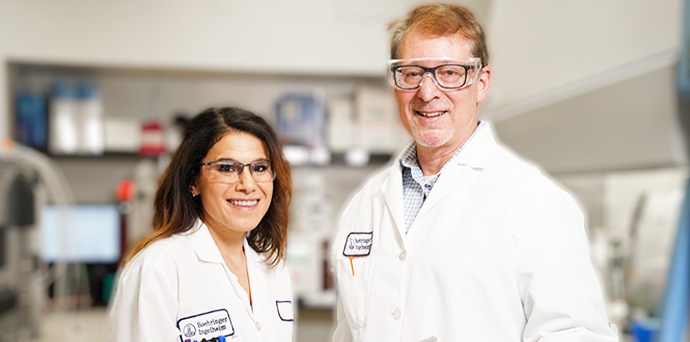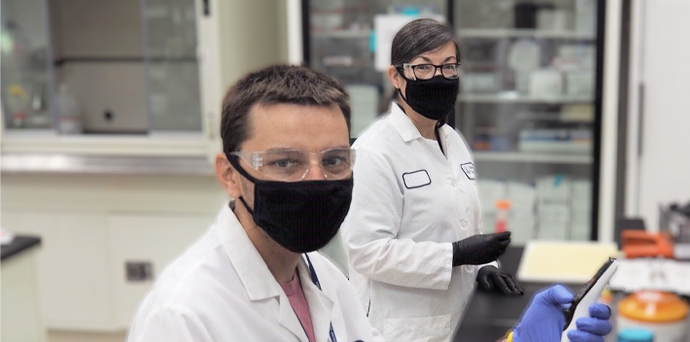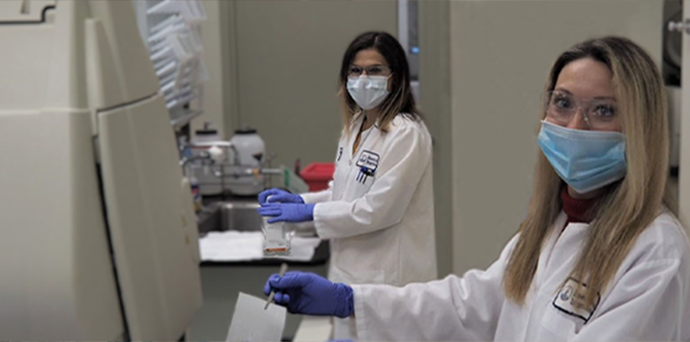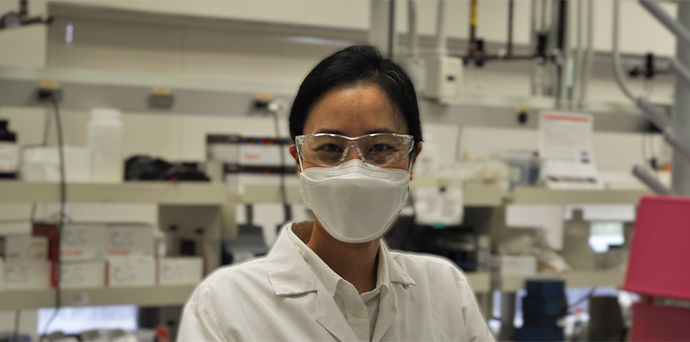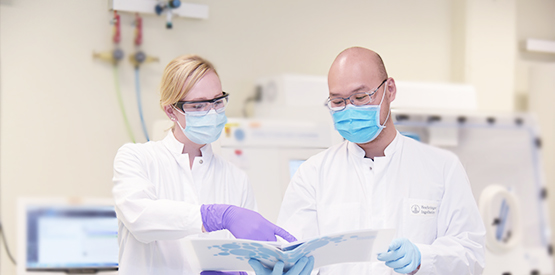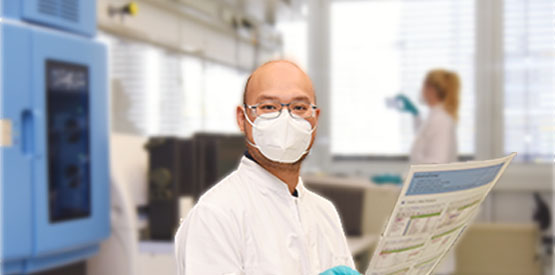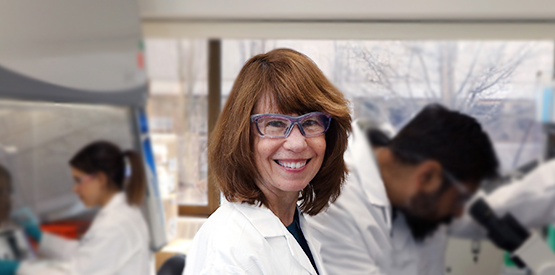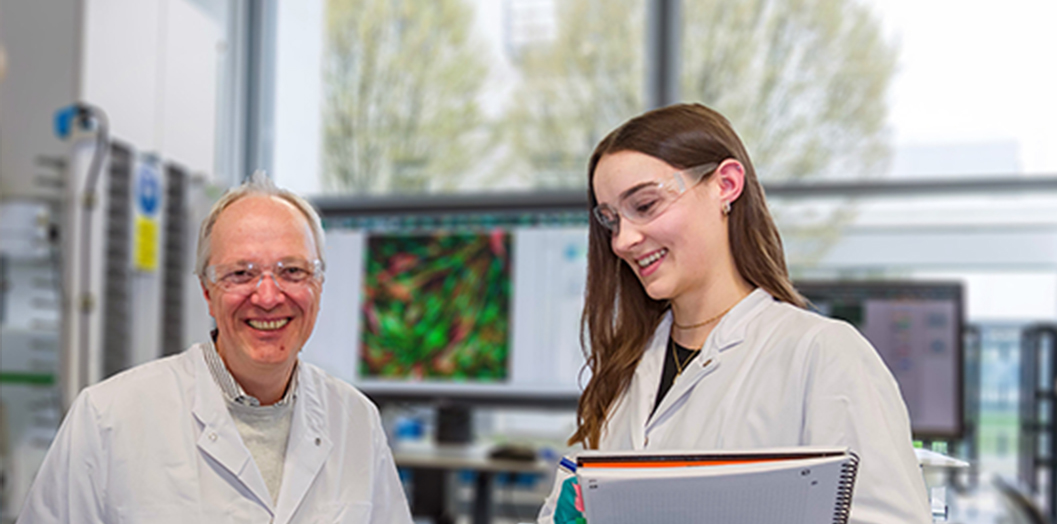Unravel the role of AGR2 in lung fibrosis
How would you propose to investigate and confirm the mechanistic roles of intracellular versus secreted anterior gradient 2 (AGR2) in the progression of lung fibrosis using disease relevant cellular models?

Heiko Stahl
Senior Scientist
Boehringer Ingelheim

Wolfgang Reindl
Principal Scientist
Boehringer Ingelheim
Call for proposals: All incoming answers accompanied by a collaboration proposal will be evaluated by a scientific jury, and, upon selection, chosen proposals are pursued through a joint collaboration with the successful applicants. Initial funding of up to 200,000 euros will be available for each selected proposal.
Background information
What is the context of the problem that we would like to solve?
Idiopathic pulmonary fibrosis (IPF) is a chronic and progressive lung disease of unknown cause, with high mortality. Currently, there are two approved antifibrotic drugs — nintedanib and pirfenidone — that slow, but do not stop the progression of fibrosis. Therefore, additional treatments are needed to inhibit or even revert the disease.
Anterior gradient 2 (AGR2) belongs to the protein disulphide isomerase family having an intracellular and extracellular function. Intracellular, it is involved in the correct folding of mucins within the ER linked to stress modulation. Extracellular, the soluble form of AGR2 has been characterized as an oncoprotein biomarker. In this context, AGR2 is involved in regulating tumor cell migration, proliferation, and metastasis1. Further, soluble AGR2 is reported to enhance the epithelial to mesenchymal transition (EMT) process in many tumor cell models2.
An increased expression of AGR2 was also found in fibrotic lungs of Progressive Pulmonary Fibrosis – Idiopathic Pulmonary Fibrosis (PPF-IPF) patients but its contribution towards lung fibrosis progression needs to be investigated3,4. Based on published data, AGR2 is involved in Wnt signaling via β-catenin translocation5,6. However, the exact pathway and mode of action linking AGR2 with Wnt activation remains unclear.
In the context of our opnMe call, our goal is to clarify the pathway of AGR2 (and potential interaction partners), including membrane association, internalization, and downstream signaling responsible for the pathological phenotype, ideally incorporating proximity markers. Successful proposals will be able to distinguish between the intracellular and soluble AGR2 functions relevant to lung biology.
In summary, we invite specialists in the field to propose innovative hypotheses and approaches to unravel the molecular mechanisms of enhanced AGR2 expression observed in PPF-IPF lungs. Successful participants will be able to provide a robust disease-relevant and functional cellular test system, which can readily show the impact of AGR2 modulation and distinguish between its intracellular and soluble roles.
What potential solutions could be in scope?
- We are open to any viable scientific concepts that establish a connection between AGR2 and the progression or resolution of lung fibrosis, utilizing cellular systems and/or in vivo models.
- We are interested in any scientific concepts that enable the validation of the proposed pathway and mode of action for AGR2 (and interacting partners) responsible for the pathological phenotype in the context of lung fibrosis.
- Identification and validation of proximity marker(s): Pathway or players that provide a mechanistic link between AGR2 and fibrosis
- Any unconventional but feasible approach should be based on existing assays and available tools in your laboratory
- Initial data are a plus, but conceptual proposals might be acceptable
What potential solutions would be out of scope?
- Proposals for proteomic pull-down approaches to identify AGR2 interaction partners
- Purely descriptive binding partners, without linkage to pathology
- Proposals without major focus on lung fibrosis, i.e., the role of AGR2 in tumor biology is not of interest
- Proposals that cannot distinguish between the intracellular and soluble roles of AGR2
- Proposals focusing on mechanisms of action that are unique or specific to non-human species
- Proposals for cell systems lacking applications to the disease setting
- Purely computational approaches
What benefits do we offer to you in exchange for having submitted a solution?
If your project is selected, you will have the opportunity to directly collaborate with the Immunology and Respiratory Discovery Research and Biotherapeutics Discovery teams of Boehringer Ingelheim. As an incentive specific to this opn2EXPERTS call, we offer an exclusive access to non-commercial, quality reagents and tools to validate your submitted hypotheses, should your proposal be selected by our scientific review team. In addition, you can also expect appropriate funding for the prospective collaboration period. Your exact funding request should be outlined in your proposal. As a framework, we suggest that your initial funding request is structured in milestones and does not exceed 200,000 euros per submitted project in total (including direct, indirect, overhead costs).
Our collaboration agreement will provide full transparency about each partner’s rights & obligations (including intellectual property rights). As part of the agreement, you will be encouraged to publish following the collaboration agreement (to be negotiated in good faith).
What are the key success criteria on which we base our selection for the best answer?
We are seeking research collaboration proposals that contain:
- A well-structured proposal outlining a new and compelling scientific approach including an experimental plan that will be used to test your hypothesis.
- A novel, testable working hypothesis distinct from those previously published.
- A thorough validation that includes an in-depth analysis package consisting of biochemical, and biophysical analyses.
- Outlining of the technical feasibility, and potentially existing data or previous publications that support feasibility / experience with outlined technology, based on existing techniques and established assays.
- Potentially includes (non-confidential) existing data and results.
- Your exact funding request should be outlined in your proposal based on a well-thought-through project. The project should be structured in milestones and planned with key decision points (clear Go/No-Go criteria). The funding request for the initial milestones resulting in a Go/No-Go decision should not exceed 200,000 euros per submitted project in total.
- Proven track record in the required field of expertise.
- Ability to implement the outlined solution as part of a scientific collaboration project with Boehringer Ingelheim including access to a laboratory.
- The project plan to achieve the outlined goals should not exceed more than two years in total.
What information should be included in your answer submission?
Please use our answer submission template to provide a 2-3 page non-confidential proposal (available for download here).
If confidential data exists that would strengthen the proposal, please indicate that information is available to share under a Confidential Disclosure Agreement (CDA). If we find the non-confidential concept proposal sufficiently interesting, we will execute a CDA for confidential discussions.
Summary
We are currently seeking answers for the following scientific question: How would you propose to investigate and confirm the mechanistic roles of intracellular versus secreted anterior gradient 2 (AGR2) in the progression of lung fibrosis using disease relevant cellular models?
All incoming answers accompanied by a collaboration proposal will be evaluated by a scientific jury, and, upon selection, chosen proposals are pursued through a joint collaboration with the successful applicants. Initial funding of up to 200,000 euros will be available for proposals that will receive support by our review team.
We can only accept research proposals if they arrive no later than April 10, 2024, 11:59 pm PST.
References
Extracellular AGR2 activates neighboring fibroblasts through endocytosis and direct binding to β-catenin that requires AGR2 dimerization and adhesion domains
Merugu S. B., Zhou B., Mangukiya H. B., Negi H., Ghulam R., Roy D., Qudsia S., Wang Z., Mashausi D. S., Yunus F. U., Liu G. S., Li D.
Biochem Biophys Res Commun. 2021, 573:86-92.
AGR2 is a target of canonical Wnt/β-catenin signaling and is important for stemness maintenance in colorectal cancer stem cells
Lamichane B. D., Jung S. Y., Yun J., Kang S., Kim D. Y., Lamichane S., Kim Y. J., Park J. H., Jang W. B., Ji S. T., Dehua L., Ha J. S., Kim Y. H., Kwon S.-M.
Biochem Biophys Res Commun. 2019, 515(4):600-606.



